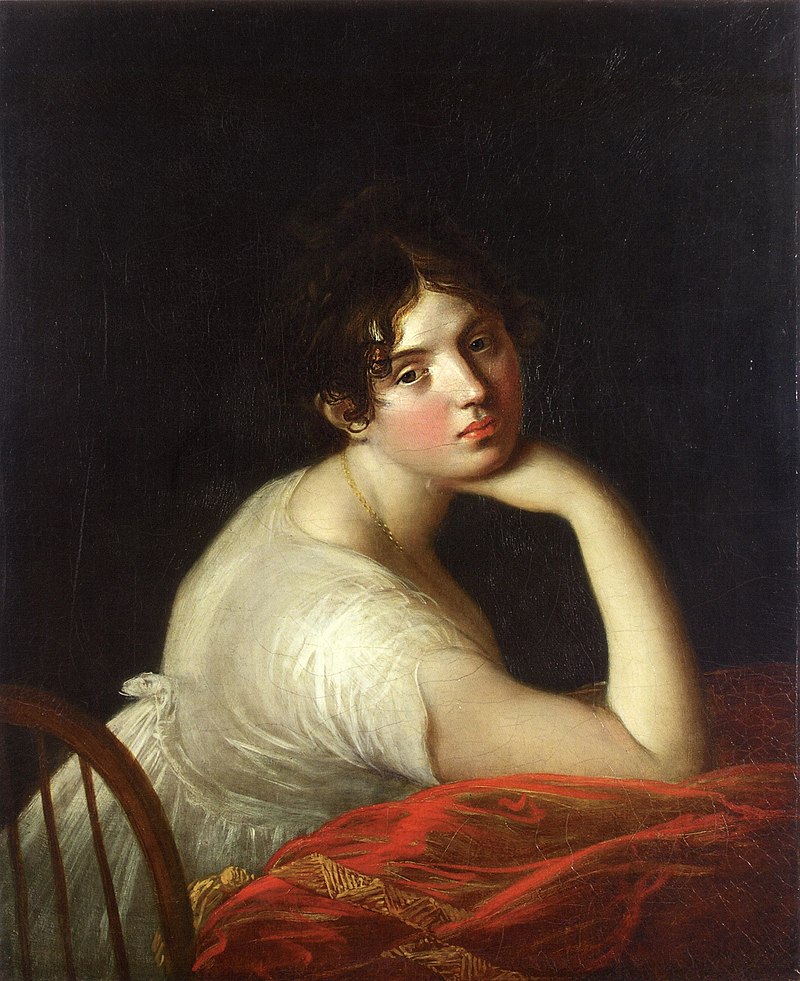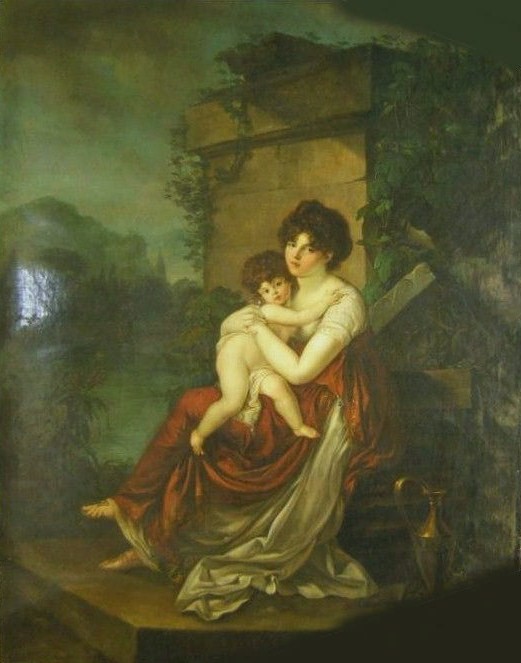by Susan Flantzer © Unofficial Royalty 2020

Maria Antonovna Naryshkina; Credit – Wikipedia
- Patronymics: In Russian, a patronymic is the second name derived from the father’s first name: the suffix -vich means “son of” and the suffixes -eva, -evna, -ova, and -ovna mean “daughter of”.
Born Princess Maria Czetwertyński-Światopełk (name often shortened and Russified to Chetvertinskaya) on February 2, 1779, in Warsaw, Poland, Maria was the second of the two daughters and the second of the three children of Polish nobleman Prince Antoni Stanisław Czetwertyński-Światopełk and his first wife Tekla von Kampenhausen.
Maria had two siblings:
- Princess Zhanetta Antonovna Chetvertinskaya (1777 – 1854), married Count Severin Vyshkovsky, no children,
- Prince Boris Antonovich Chetvertinsky (1784 – 1865), married Princess Nadezhda Fedorovna Gagarina, had nine children
Maria’s mother died when she was five years old. Her father married again to Coletta Adamovna Kholonevskaya.
Maria had two half-brothers from her father’s second marriage:
- Prince Konstantin Antonovich Chetvertinsky (1792 – 1850)
- Prince Gustav Antonovich Chetvertinsky (1794 – 1851)

The urn with the ashes of Prince Antoni Stanisław Czetwertyński-Światopełk surrounded by his widow Coletta Adamovna Kholonevskaya with her two young sons, Konstantin and Gustav. On the right side are the children of Prince Chetvertinsky from his first marriage: son Boris and daughters Maria and Zhanetta; Credit – Wikipedia
Maria’s father Prince Antoni Stanisław Czetwertyński-Światopełk was a member of the parliament of the Polish–Lithuanian Commonwealth and took the side of the Russian Empire in many matters that came before the parliament. During the Kościuszko Uprising, he was imprisoned by the Polish revolutionaries. On June 28, 1794, an angry mob stormed the prison, and Prince Antoni Stanisław Czetwertyński-Światopełk was hanged with other people declared traitors.
Catherine II (the Great), Empress of All Russia ordered Prince Antoni Stanisław Czetwertyński-Światopełk’s widow and children to be brought to St. Petersburg and provided for them. As adults, Maria’s brothers had positions at the Russian court and/or in the government. Her sister was the mistress of Grand Duke Konstantin Pavlovich, the brother of Alexander I, Emperor of All Russia.

Maria’s husband, Dmitry Lvovich Naryshkin; Credit – Wikipedia
Maria was fifteen years old when she arrived in St. Petersburg and was made a maid-of-honor at the Russian court. Catherine the Great arranged a marriage for her, and in 1795, she married 31-year-old Dmitry Lvovich Naryshkin, from a rich noble family, and a courtier at the Russian court where he held several high positions over the years.

Naryshkin-Shuvalov Palace; Credit – Wikipedia
Maria and her husband lived a life of extravagant luxury. They were famous for hosting balls at their St. Petersburg palace, now known as the Naryshkin-Shuvalov Palace on the Fontanka River Embankment. Today, it is the site of the Faberge Museum in St. Petersburg. Maria was known for her dazzling beauty and attracted the attention of Tsesarevich Alexander Pavlovich, the future Alexander I, Emperor of All Russia.

Alexander I, Emperor of All Russia: Credit – Wikipedia
Tsesarevich Alexander Pavlovich was the eldest son and heir of Paul I, Emperor of All Russia, who had succeeded his mother Catherine II (the Great) upon her death in 1796. In 1793, Catherine the Great arranged a marriage between her grandson Alexander and Louise of Baden, known as Elizabeth Alexeievna after her marriage. Alexander and Elizabeth Alexeievna’s marriage started to falter. With the approval of Maria’s husband, Alexander started a long-term affair with Maria in 1799 and Elizabeth Alexeievna sought affection from her husband’s friend Prince Adam Czartoryski, a Polish noble. In 1799, Elizabeth Alexeievna gave birth to a daughter Maria Alexandrovna, who had dark eyes and dark hair like Prince Adam Czartoryski, unlike the blond hair and blue eyes of both Alexander and Elizabeth Alexeievna. Elizabeth Alexeievna had one more daughter but both daughters died in early childhood.
Maria and Alexander’s affair lasted for nearly nineteen years. After Alexander became Emperor of All Russia following the assassination of his father in 1801, his marriage was one in name only. Both Alexander and Elizabeth Alexeievna fulfilled their duties as Emperor and Empress. However, Alexander continued his long-term affair with Maria, and Elizabeth Alexeievna continued her affair with Prince Adam Czartoryski.

Maria Antonovna Naryshkina with her daughter Marina; Credit – Wikipedia
Maria had six children who were officially considered the children of Maria’s husband Dmitry Lvovich Naryshkin but their paternity is uncertain. The eldest Marina was the child of Dmitry as Maria’s affair with Alexander I started in 1799, after Marina’s birth. Sophie was the only child officially recognized by Alexander I. There are suspicions that Maria had an affair with Prince Grigory Ivanovich Gagarin, a diplomat and a poet, in 1813-1816, and that Maria’s son Emmanuel may have been Gagarin’s.
- Marina Dmitrievna Naryshkina (1798 – 1871), married Count Nikolai Dmitrievich Guryev, had four children
- Elizabeth Dmitrievna Naryshkina (1802 – 1803), died in infancy
- Elena Dmitrievna Naryshkina (1803 – 1804), died in infancy
- Sophia Dmitrievna Naryshkina (1805 – 1824), died from tuberculosis at age 18
- Zinaida Dmitrievna Naryshkina (1807 – 1810), died in early childhood
- Emanuel Dmitrievich Naryshkin (1813 – 1901), married (1) Ekaterina Nikolaevna Novosiltseva, no children (2) Alexandra Nikolaevna Chicherina, no children
In 1815, Maria accompanied Alexander I, Emperor of All Russia to the Congress of Vienna, causing a scandal. Eventually, Maria began to worry about her position and the gossip surrounding her and Alexander began to have pangs of guilt about the long-term affair. In 1818, the affair ended and Alexander went back to his wife Elizabeth Alexeievna but he continued to talk about Maria as his family.

Maria in 1838; Credit – Wikipedia
Maria returned to her husband Dmitry Lvovich Naryshkin and they lived in Odessa, Russia on the Black Sea. On December 1, 1825, 47-year-old Alexander I, Emperor of All Russia died in Elizabeth Alexeievna’s arms from typhus. He was succeeded by his brother Nicholas I, Emperor of All Russia. Dmitry Lvovich Naryshkin died on March 31, 1838, aged 73, and was buried in the Annunciation Church of the Alexander Nevsky Lavra in St. Petersburg. In 1842, Maria left Russia and moved to Munich, Kingdom of Bavaria, now in the German state of Bavaria, where she lived with the family of Count von Rechberg.
Maria Antonovna Naryshkina, aged 75, died on September 6, 1854, in Starnberg, Kingdom of Bavaria, now in the German state of Bavaria. She was buried in the Alter Südfriedhof (Old South Cemetery) in Munich.

Tomb of Maria Antonovna Naryshkina; Credit – Von HubertSt – Eigenes Werk, CC BY-SA 4.0, https://commons.wikimedia.org/w/index.php?curid=50916498
This article is the intellectual property of Unofficial Royalty and is NOT TO BE COPIED, EDITED, OR POSTED IN ANY FORM ON ANOTHER WEBSITE under any circumstances. It is permissible to use a link that directs to Unofficial Royalty.
Works Cited
- De.wikipedia.org. 2020. Marija Antonowna Naryschkina. [online] Available at: <https://de.wikipedia.org/wiki/Marija_Antonowna_Naryschkina> [Accessed 3 July 2020].
- En.wikipedia.org. 2020. Maria Naryshkina. [online] Available at: <https://en.wikipedia.org/wiki/Maria_Naryshkina> [Accessed 3 July 2020].
- Flantzer, Susan, 2018. Alexander I, Emperor Of All Russia. [online] Unofficial Royalty. Available at: <https://www.unofficialroyalty.com/emperor-alexander-i-of-russia/> [Accessed 3 July 2020].
- Lincoln, W. Bruce. (1981). The Romanovs: Autocrats of All the Russias. New York, NY.: Doubleday
- Massie, R. (2016). Catherine the Great. London: Head of Zeus.
- Ru.wikipedia.org. 2020. Святополк-Четвертинский, Антоний Станислав. [online] Available at: <https://ru.wikipedia.org/wiki/%D0%A1%D0%B2%D1%8F%D1%82%D0%BE%D0%BF%D0%BE%D0%BB%D0%BA-%D0%A7%D0%B5%D1%82%D0%B2%D0%B5%D1%80%D1%82%D0%B8%D0%BD%D1%81%D0%BA%D0%B8%D0%B9,_%D0%90%D0%BD%D1%82%D0%BE%D0%BD%D0%B8%D0%B9-%D0%A1%D1%82%D0%B0%D0%BD%D0%B8%D1%81%D0%BB%D0%B0%D0%B2> [Accessed 3 July 2020].
- Ru.wikipedia.org. 2020. Нарышкин, Дмитрий Львович. [online] Available at: <https://ru.wikipedia.org/wiki/%D0%9D%D0%B0%D1%80%D1%8B%D1%88%D0%BA%D0%B8%D0%BD,_%D0%94%D0%BC%D0%B8%D1%82%D1%80%D0%B8%D0%B9_%D0%9B%D1%8C%D0%B2%D0%BE%D0%B2%D0%B8%D1%87> [Accessed 3 July 2020].
- Ru.wikipedia.org. 2020. Нарышкина, Мария Антоновна. [online] Available at: <https://ru.wikipedia.org/wiki/%D0%9D%D0%B0%D1%80%D1%8B%D1%88%D0%BA%D0%B8%D0%BD%D0%B0,_%D0%9C%D0%B0%D1%80%D0%B8%D1%8F_%D0%90%D0%BD%D1%82%D0%BE%D0%BD%D0%BE%D0%B2%D0%BD%D0%B0> [Accessed 3 July 2020].
